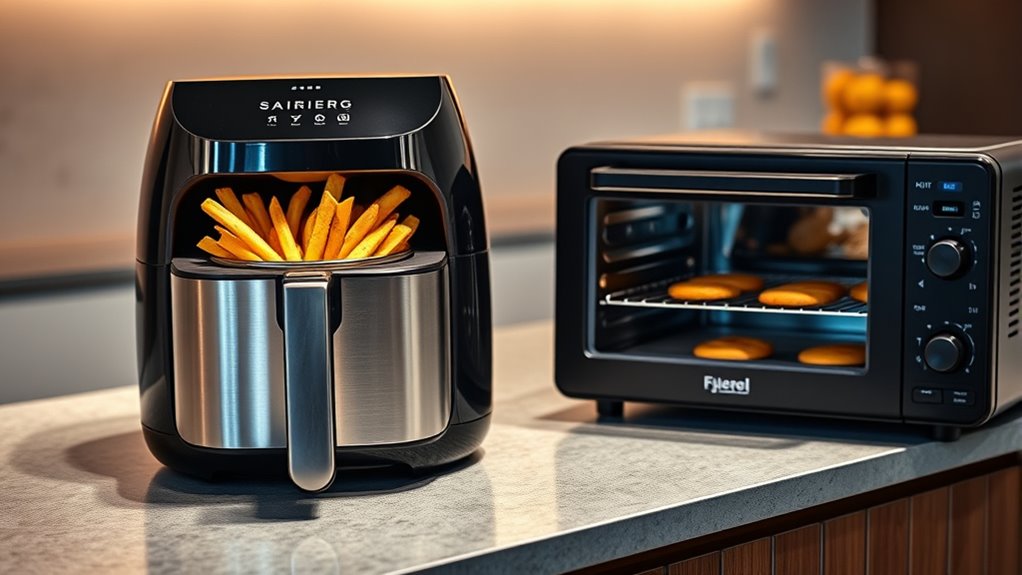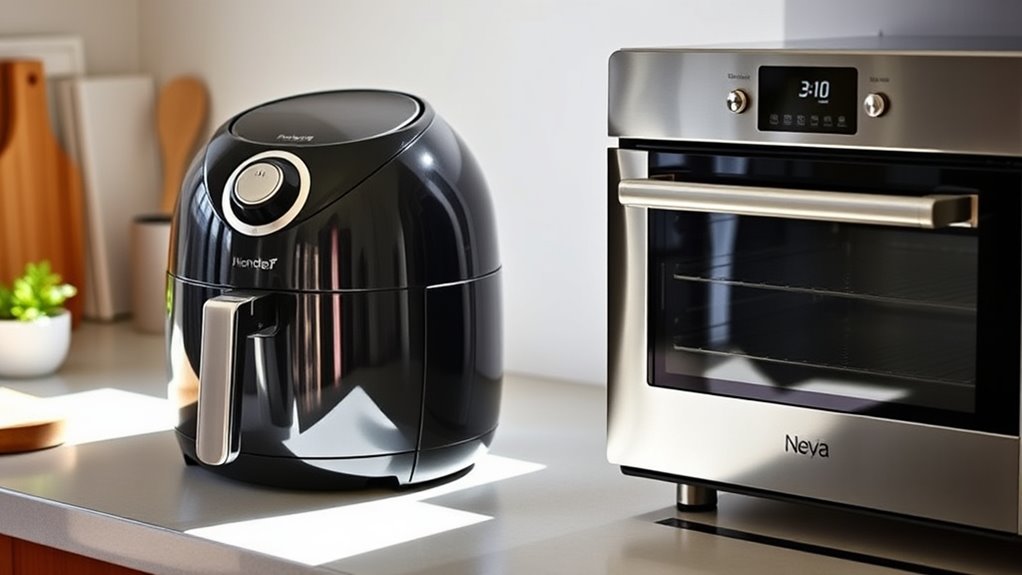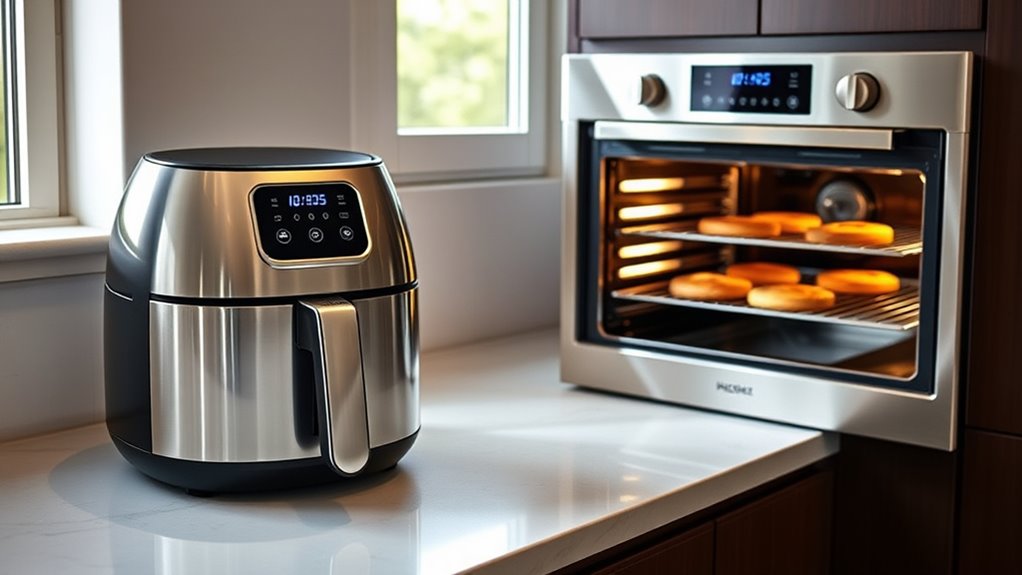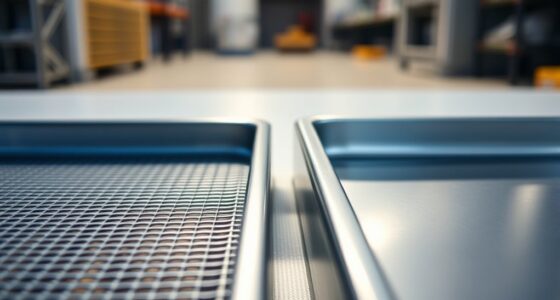If you’re comparing energy costs, an air fryer uses about 1,500 watts for 30 minutes, costing roughly $0.08 to $0.09 per use, while a convection oven uses around 3,000 watts, costing $0.15 to $0.25 for the same period. This makes air fryers more energy-efficient and cheaper to operate over time. To discover how these differences impact your household expenses and cooking needs, explore the details further.
Key Takeaways
- Air fryers consume about 0.75 kWh per 30 minutes, while convection ovens use approximately 1.5 kWh, making them more energy-intensive.
- The operational cost per use for air fryers ($0.08–$0.09) is significantly lower than convection ovens ($0.15–$0.25).
- Faster cooking times with air fryers reduce overall energy consumption compared to convection ovens.
- Annual energy expenses for air fryers are typically $9–$12, versus $30–$50 for convection ovens.
- Smaller capacity and rapid preheating features make air fryers more cost-effective for quick, small meals.
How Much Energy Do Air Fryers and Convection Ovens Use?

When comparing energy use, air fryers generally consume about half the power of convection ovens for similar cooking tasks. An air fryer typically operates at around 1,500 watts, using roughly 0.75 kWh over 30 minutes, while a convection oven uses about 3,000 watts, or 1.5 kWh for the same period. Because of their smaller size and rapid cooking times, air fryers are more energy-efficient, reducing overall energy consumption and costs. Convection ovens often require preheating and have larger internal volumes, which increase energy use. The difference in wattage and preheating needs means air fryers use less electricity per meal, making them a more efficient choice for quick, small meals. Energy efficiency is further improved by their ability to cook food faster without sacrificing quality. Additionally, kitchen appliances designed for faster cooking can further enhance energy savings. Moreover, the power consumption of these appliances can vary based on model and usage patterns, emphasizing the importance of choosing energy-efficient units. Implementing energy-saving practices can further optimize their efficiency and reduce electricity bills. For example, selecting models with energy star ratings can lead to additional savings and environmental benefits.
Comparing Operating Costs for Home Cooking

Comparing the operating costs of air fryers and convection ovens reveals significant savings over time. An air fryer typically uses around 1,500 watts, which means lower power consumption and reduced electricity bills for home cooking. Its shorter preheat time and rapid cooking speeds lead to notable energy savings compared to a convection oven, which often operates between 1,800 to 2,500 watts. Cooking with an air fryer generally costs about $0.08 to $0.09 per use, while a convection oven can cost $0.15 to $0.25 depending on duration and wattage. Over a year, using an air fryer for roughly 300 hours can save you approximately $20–$50 in energy costs, making it a more economical choice for everyday home cooking.
Speed and Efficiency in Daily Meal Preparation

Air fryers deliver rapid meal preparation thanks to their smaller chambers and advanced superconvection technology, which circulate hot air more efficiently. This results in faster cooking times and greater energy efficiency compared to convection ovens. With minimal preheating required, an air fryer saves you 10-15 minutes in food preparation and reduces electricity consumption. For similar recipes, an air fryer can finish cooking in about 18-20 minutes, while a convection oven may take 35-50 minutes. The quick heat circulation produces crispy textures faster, enabling fast cooking for busy schedules. Overall, an air fryer’s superior cooking speed and energy efficiency make it ideal for daily meal prep, delivering energy savings while ensuring your food is ready quickly and efficiently.
Practical Applications and When to Choose Each Appliance

Choosing between an air fryer and a convection oven depends on your specific cooking needs and household size. If you want quick cooking, crispy textures, and lower energy consumption, an air fryer is ideal for small to medium meals. The air fryer provides faster preheating and energy-efficient operation for quick, small meals. For large dishes, baking, or multiple items, a convection oven offers more food capacity and consistent results. Convection ovens are often used in professional settings and feature specialized heating elements that promote even cooking. Consider the table below:
| Use Case | Recommended Appliance |
|---|---|
| Quick snacks, reheating | Air fryer |
| Large meals, baking | Convection oven |
| Small portions, crispy results | Air fryer |
The convection oven suits larger, complex meals, balancing cost savings with food capacity and cooking times. Additionally, the rising popularity of investment platforms underscores the importance of efficient appliances in modern kitchens. An understanding of energy consumption can help consumers make informed choices to reduce utility costs.
Overall Cost-Effectiveness and Long-Term Savings

Since air fryers typically cook faster and use less energy per session, they are often more cost-effective over the long term compared to convection ovens. Their superior energy efficiency results in lower energy costs, reducing your utility bills and operating costs. With shorter cook times and smaller capacity, air fryers consume less power during each use, leading to notable household savings. Additionally, their energy-efficient design helps minimize overall household energy consumption, making them a more environmentally friendly option. Proper filtration systems contribute to cleaner air and healthier indoor environments, especially in households with allergy sufferers or pets. Over a year, energy expenses for an air fryer can range from $9 to $12, while convection ovens may cost $30 to $50, depending on usage frequency. Although larger models may approach convection oven energy use, most small to medium-sized air fryers remain a smarter choice for long-term savings, offering a better cost comparison and lower total power usage over time. Energy efficiency plays a crucial role in determining overall cost-effectiveness, and understanding air purifier maintenance can further reduce household costs by maintaining optimal appliance performance. Additionally, selecting appliances with smart energy features can enhance savings and efficiency.
Frequently Asked Questions
Does an Air Fryer Use Less Electricity Than a Convection Oven?
You might wonder if an air fryer uses less electricity than a convection oven. The answer is yes; air fryers typically consume about half the electricity because they operate at around 1,500 watts, compared to convection ovens that use 2,000 to 3,000 watts. Their smaller size, shorter preheat, and faster cooking times make air fryers more energy-efficient, saving you money on electricity bills for similar cooking tasks.
Which Is Cheaper to Run, an Air Fryer or an Oven?
When weighing which appliance will work wonders for your wallet, consider this: an air fryer often wins the race by using less power and time, making it cheaper to run than a traditional oven. You’ll save considerably on energy costs with rapid preheating and quick cooking. So, if you’re after affordability and efficiency, an air fryer is your better bet for budget-friendly, brisk baking.
Why Are People Getting Rid of Air Fryers?
You’re wondering why people are ditching air fryers. Many find their limited capacity requires multiple batches, making them less efficient. Larger convection ovens offer more versatility and can handle bigger meals, reducing the need for multiple cooking cycles. Additionally, cheaper air fryers tend to have shorter lifespans and mechanical issues. As multifunctional appliances grow in popularity, folks prefer more durable, all-in-one options, leading to the decline of standalone air fryers.
Does an Air Fryer Use a Lot of Electricity?
Like a flashlight uses just a little battery power, an air fryer doesn’t use a lot of electricity. You’ll find it’s quite energy-efficient, especially for small meals. It typically consumes around 1,500 watts, which is half of a convection oven’s power. For a 30-minute cook, it costs less—about 9 cents in NY—making it a smart, economical choice for quick, tasty meals without draining your energy bill.
Conclusion
As you consider your kitchen options, imagine the aroma of crispy fries from your air fryer or the warm scent of baked cookies from your convection oven. Whether you choose speed or versatility, both appliances can fit into your daily routine, saving energy and time. Sometimes, a simple switch is all it takes to enhance your cooking experience—turning a busy weekday into a cozy, delicious moment you’ll look forward to.









